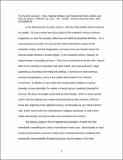Review of The Arsenic Century: How Victorian Britain was Poisoned at Home, Work, and Play
Author(s)
Ritvo, Harriet
Downloadwhorton.The Arsenic Century.vsrev.pdf (17.89Kb)
OPEN_ACCESS_POLICY
Open Access Policy
Creative Commons Attribution-Noncommercial-Share Alike
Terms of use
Metadata
Show full item recordAbstract
In this disheartening chronicle, James C. Whorton fully justifies both his title and his subtitle. Of course arsenic was not a product of the nineteenth–century chemical imagination, as were, for example, aniline dyes and artificial phosphate fertilizers. It is a chemical element (number thirty-three in the periodic table, itself another product of the nineteenth-century chemical imagination), and many of its uses had been known for centuries before Whorton’s account begins. In the nineteenth century, however, its impact became increasingly pervasive. There were several reasons for this shift. Arsenic often occurs naturally in association with other metals, and it was produced in large quantities as a by-product of mining and smelting. It turned out to have numerous commercial applications, and so it was widely disseminated in the Victorian environment. In addition, it was [End Page 140] readily and inexpensively available as a poison (intended, at least ostensibly, for rodents or insects) and as a medicine (intended for humans). But these two targets could easily be interchanged. While in earlier periods arsenic had been deployed as a weapon predominantly by elite murderers, Whorton shows that, beginning in the eighteenth century, its homicidal use was “democratized” (xiii). Death could result from unintentional or negligent poisoning as well as from malice aforethought, but only the latter was considered to be criminal.
Date issued
2011-09Department
Massachusetts Institute of Technology. History SectionJournal
Victorian Studies
Publisher
Indiana University Press
Citation
Ritvo, Harriet. Review of: The Arsenic Century: How Victorian Britain was Poisoned at Home,
Work, and Play by James C. Whorton (Oxford and New York: Oxford University Press,
2010), Victorian Studies 54.1 (Autumn 2011) pp. 140-142.
Version: Author's final manuscript
ISSN
0042-5222